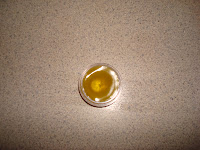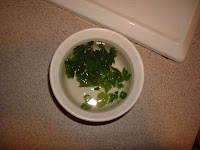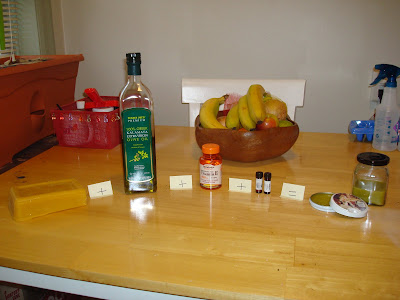Hey all! Lately, Pinterest has sent me on all kinds of homemade body product experiments. A few weeks ago I tried my hand at making liquid hand soap/body wash out of a bar of soap. It sounded so easy, but I managed to fail at it completely. I chalked it up to using a different kind of soap than the recipe had called for, which was Dove. I am trying to go for more natural and safer products, so I continued my search for a recipe that used a healthier soap.
I found another recipe very quickly on Pinterest, as they are certainly
not hard to come by.
This recipe called for the use of Mrs. Meyer's Clean Day bar soap. I looked up Mrs. Meyers on
EWG's Skin Deep Cosmetics Database to see how it rated. I love and hate this site. It knows too much! I have avoided looking up some of my make-up products for fear that I will have to stop using them and start using some expensive type. But, it is helpful if you're trying to choose safe products and are ready to make a change.
Mrs. Meyer's rated a 4-5 on the database. A little too high for my liking. So, I checked Dr. Bronner's Pure Castile bar soap, which rated a 1. Bingo! I had read in the comments section of the recipe that a few people had used Dr. Bronner's with success. So, I decided this would be my second attempt and luckily, two times was a charm for me. This recipe worked perfectly and the soap is very nice. I have been using it for hand soap so far, but I plan on using it for body wash when mine runs out. I am also considering it for shampoo when that runs out, because the bar does say it is an all-in-one. I mean, I do have a gallon of this stuff, I may as well put it to good use, right?
If you prefer Mrs. Meyer's and don't care about a higher risk rating, these recipes are identical for both bars. Please note that it requires a full 8oz bar of soap. So, you may need to buy two bars of soap, as most bars are only 4oz. Dr. Bronners was actually 5oz, but I used up both bars and the couple extra ounces didn't effect anything.
Recipe:
8oz Bar Soap (I recommend using either Mrs. Meyer's or Dr. Bronner's to ensure the soap turns out correct. Using another type may not work, as I learned with my first attempt at making homemade soap.)
2 Tbsp Liquid Glycerin (Usually found in first aid section, ask an employee to help find it)
1 Gallon of water (I used tap water)
Vitamin E (optional for preservative)
First, with a cheese grater, grate your soap. You can buy a grater at a thrift store or use your kitchen one. It doesn't matter since soap washes right off and adds a nice, clean shine too! This step was less time-consuming than I thought it would be, because the soap is soft and grates very quickly.
Next, in a large pot, add one gallon of water, 2 Tbsp of glycerin and all of your soap flakes. Heat over medium heat, stirring occasionally to ensure that the flakes are dissolving. I would recommend using a stock pot, if you have one. I do not have one, so I used my largest pot, which didn't allow me to use a full gallon of water. My soap still turned out fine, but you'll get more bang for your buck if you're able to put a full gallon of water in the pot.

When the soap flakes are completely dissolved. Let me repeat. Completely dissolved, and no sooner, you can remove the pot from the heat. You'll have what you see above: warm, soapy water. Now, this is the hard part *wink* let your soap soup sit for a good 10-12 hours. I made mine in the evening and let it sit overnight. Do not cover the pot, so that it cools and thickens faster. I should note that 10-12 hours is not a hard and fast rule. If yours is still not thickened in 12 hours, give it a good stir with a spoon, leave it alone for an hour or two and recheck it. I read comments that stirring it a little suddenly caused it to thicken right up.

After the wait period, it will be either the perfect consistency or thick. Mine was like a jelly, so do not be surprised if yours is as well. This is not bad! Simply use a hand mixer on low speed while adding a little more water. Mix for 30 seconds to 1 minute being sure to get all of the areas mixed. This is also the time to add the Vitamin E oil if you choose to.
Your soap will bubble up like a bubble bath and the consistency will become exactly like liquid soap.The soap may have a loose "snot-like" consistency, which sounds gross, but is exactly what you're going for. When you pour it, it tends to pull more soap along with it, rather than separating. You'll see what I mean in the next step.
Using a ladle and a funnel, spoon your soap into your desired container and storage containers. I have read reports of milk gallon jugs breaking down and leaking if the soap is kept in there for too long, so I would recommend using glass jars or a thicker-walled plastic jug if you think you won't go through this very quickly. Those of you with children, or those multi-purposing this into body wash and shampoo as well, will probably go through this much faster.
Cost work-up:
1 bar of soap @ $3.29 x 2 = $6.58
6oz Glycerin @ $4.99 / 6 = $.83
1 Gallon tap water @ free
2 Tbsp of Glycerin is equal to 1oz, leaving me with 5 more oz for subsequent batches of soap. So, a gallon (128oz) of hand soap/body wash/shampoo cost me: $6.58 (soap) + $.83 (glycerin) = $7.41 total!
I don't know about you, but that is way less than I spend normally, and we're getting a healthy, natural and low-risk product too. I hope you all enjoy your soap, I know I do!


















































